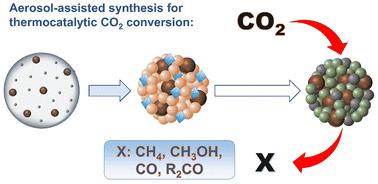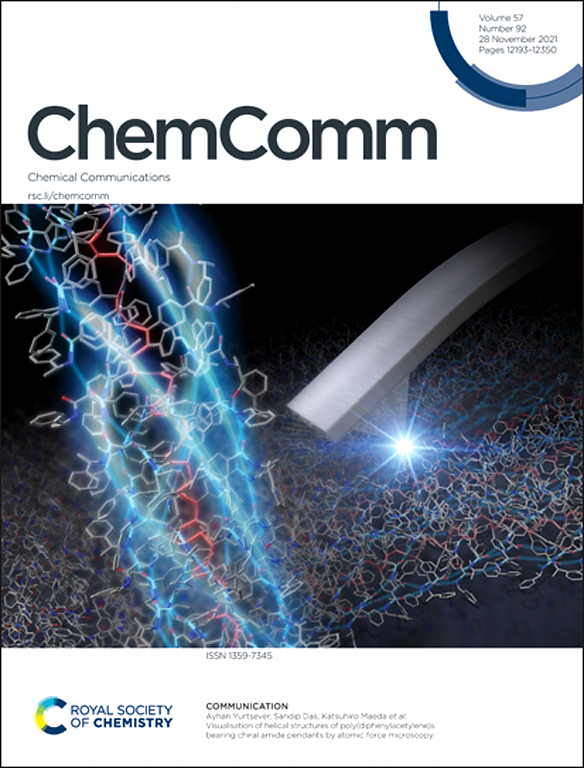气溶胶辅助合成CO2利用的杂化/复合多孔纳米结构
IF 4.2
2区 化学
Q2 CHEMISTRY, MULTIDISCIPLINARY
引用次数: 0
摘要
全球对可持续碳管理的迫切需求加强了对二氧化碳转化的先进材料和催化过程的研究。这篇专题文章重点介绍了气溶胶辅助合成(AAS)路线的交叉和为热催化CO2转化量身定制的功能混合/复合多孔纳米结构的发展。AAS提供了一个独特的、通用的、可扩展的平台,用于制造混合/复合纳米结构,这些纳米结构具有可调孔隙率、定制成分和分层结构,这些属性对于提高催化性能、热稳定性和抗失活能力至关重要。这篇综述文章概述了原子吸收法的基本原理,包括:作为起点的气溶胶的产生,从液滴/蒸气到纳米颗粒的前驱体转化,用于飞行结构控制的粒子操纵,以及通过工程孔隙形成纳米结构。它进一步讨论了用于催化混合/复合纳米结构的常见和先进的原子吸收光谱技术,如气溶胶喷雾热解,三流体喷嘴喷雾干燥策略,基于火焰的气溶胶工艺(包括双火焰喷雾热解及其不对称变体),以及结合溶胶-凝胶化学,表面活性剂辅助模板和微流体处理的混合方法。aas衍生的功能多孔纳米结构在一系列热催化CO2转化过程中的应用被探索,包括CO2加氢(甲醇合成、甲烷化和逆水气转换)、甲烷干重整、甲烷双重整、碳酸化反应(如碳酸二甲酯合成)和其他新兴途径。本文最后对当前面临的挑战和未来的研究方向进行了批判性的展望,强调了aas对结构-功能关系的控制对优化催化活性和选择性的重要性,以实现二氧化碳的可持续利用。本文章由计算机程序翻译,如有差异,请以英文原文为准。

Aerosol-assisted synthesis of hybrid/composite porous nanostructures for CO2 utilization
The urgent global demand for sustainable carbon management has intensified research into advanced materials and catalytic processes for CO2 conversion. This feature article focuses on the intersection of aerosol-assisted synthesis (AAS) routes and the development of functional hybrid/composite porous nanostructures tailored for thermocatalytic CO2 conversions. AAS provides a unique, versatile, and scalable platform for fabricating hybrid/composite nanostructures with tunable porosity, tailored compositions, and hierarchical architectures—attributes that are critical for enhancing catalytic performance, thermal stability, and resistance to deactivation. The review article provides an overview of the fundamental principles underlying AAS, including: aerosol generation as the starting point, precursor transformation from droplet/vapor to nanoparticle, particle manipulation for in-flight structure control, and nanostructure formation with engineered porosity. It further discusses both common and advanced AAS techniques developed for catalytic hybrid/composite nanostructures, such as aerosol spray pyrolysis, spray drying with a three-fluid nozzle strategy, flame-based aerosol processes (including double flame spray pyrolysis and its asymmetrical variant), and hybrid approaches integrating sol–gel chemistry, surfactant-assisted templating, and microfluidic processing. The applications of AAS-derived functional porous nanostructures are explored across a range of thermocatalytic CO2 conversion processes, including CO2 hydrogenation (methanol synthesis, methanation, and reverse water–gas shift), dry reforming of methane, bi-reforming of methane, carbonation reactions (e.g., dimethyl carbonate synthesis), and other emerging pathways. The review article concludes with a critical perspective on current challenges and future research directions, highlighting the importance of AAS-enabled control over structure–function relationships to optimize catalytic activity and selectivity for sustainable CO2 utilization.
求助全文
通过发布文献求助,成功后即可免费获取论文全文。
去求助
来源期刊

Chemical Communications
化学-化学综合
CiteScore
8.60
自引率
4.10%
发文量
2705
审稿时长
1.4 months
期刊介绍:
ChemComm (Chemical Communications) is renowned as the fastest publisher of articles providing information on new avenues of research, drawn from all the world''s major areas of chemical research.
 求助内容:
求助内容: 应助结果提醒方式:
应助结果提醒方式:


